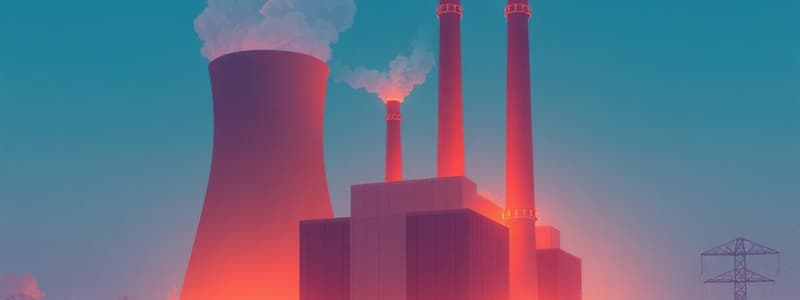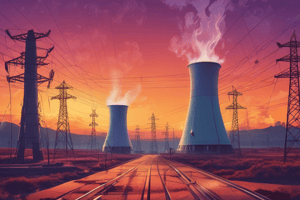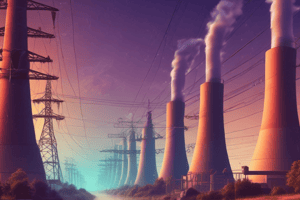Podcast
Questions and Answers
What is the primary energy transformation that occurs in a generator?
What is the primary energy transformation that occurs in a generator?
- Electrical energy to mechanical energy
- Thermal energy to chemical energy
- Mechanical energy to electrical energy (correct)
- Chemical energy to electrical energy
In the context of power plants, what device directly spins to generate electricity?
In the context of power plants, what device directly spins to generate electricity?
- Combustion chamber
- Turbine (correct)
- Boiler
- Condenser
What is released during the combustion of fuel?
What is released during the combustion of fuel?
- Carbon dioxide and water (correct)
- Nitrogen and oxygen
- Hydrogen and helium
- Methane and sulfur
What does the Law of Conservation of Energy state?
What does the Law of Conservation of Energy state?
What happens to energy that is 'lost' due to the second law of thermodynamics?
What happens to energy that is 'lost' due to the second law of thermodynamics?
What is efficiency in an energy system?
What is efficiency in an energy system?
What is the formula to calculate energy efficiency (E)?
What is the formula to calculate energy efficiency (E)?
What is a calorie defined as?
What is a calorie defined as?
Flashcards
Combustion
Combustion
The process of burning fuel with oxygen to produce carbon dioxide and water.
Electricity Generation Process
Electricity Generation Process
Burning fuel heats fluid, which rotates a turbine, which drives a generator to produce electricity
Law of Conservation of Energy
Law of Conservation of Energy
Energy cannot be created or destroyed; it only changes form.
Energy Efficiency (Definition)
Energy Efficiency (Definition)
Signup and view all the flashcards
Energy Efficiency (Formula)
Energy Efficiency (Formula)
Signup and view all the flashcards
Calorie
Calorie
Signup and view all the flashcards
BTU (British Thermal Unit)
BTU (British Thermal Unit)
Signup and view all the flashcards
Energy Degradation
Energy Degradation
Signup and view all the flashcards
Study Notes
- Electricity generation demonstrated through hand crank generators and a model steam turbine
Combustion Process
- The combustion process is chemically represented as: Fuel + O2 → CO2 + H2O
- Plant Scherer in Georgia uses this process
Electricity Production by a Generator
- Coal combustion heats a fluid
- Fluid (steam, water, or wind) rotates a turbine
- A turbine drives a generator
- The generator finally produces electricity
Energy Conversion in a Coal-Fired Power Plant
- Chemical energy from coal converts to thermal energy to produce steam in the boiler, which in turn becomes mechanical energy in the turbine
- The turbine results in electrical energy from the generator, which is then sent to users
Law of Conservation of Energy
- Energy is not destroyed but changed into other forms
- For example, 825 J of electrical energy in a hair dryer converts into 125 J of kinetic energy, 150 J of sound energy, and 550 J of thermal energy
Efficiency in Energy Conversion
- Second law of thermodynamics states energy degrades to low-quality waste heat and is lost to the environment with each conversion
- More efficient systems convert more fuel energy to useful energy
BTU and Calories
- Coal and natural gas possess chemical bond energy measured in BTU (British thermal units), convertible to calories
- 1 calorie is the energy needed to raise 1 gram of water by 1 degree Celsius
- 1 calorie = 0.00396573 BTU
- 1 BTU = 252 calories
Energy Efficiency Calculation
- Energy efficiency (E) is calculated as a percentage: E = (Energy Produced / Energy Consumed) x 100%
Efficiency Example: Coalville Power Plant
- The Coalville Power Plant generates 64,423 megawatt hours (64,423,000 kilowatt hours) of electricity by burning 31,796,825 metric tons (35,050 tons) of coal
- 1 kwh = 3413 BTU
- BTU value of coal = 9800 BTU/lb
- 2000 lb = 1 ton
- The plant's energy efficiency (E) equals 32%
- 68% of the energy in coal is lost as waste heat
Energy Efficiency as a Product of Individual Efficiencies
- The conversion of coal into light via an incandescent light bulb is only 1.6% efficient
System Efficiency Comparison
- Calculating the overall efficiencies of two systems reveals that power plants play a significant role
- Coal to electricity in power plants produces only 6% power
- Using natural gas produces 11%
Studying That Suits You
Use AI to generate personalized quizzes and flashcards to suit your learning preferences.
Related Documents
Description
Explore electricity generation through combustion, turbines, and generators. Understand energy conversion in power plants, focusing on how chemical energy transforms into thermal, mechanical, and finally, electrical energy. The Law of Conservation of Energy is also discussed.




